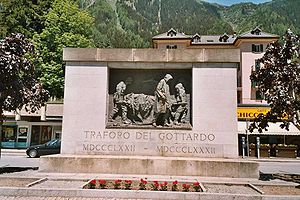Gotthard Tunnel




The Gotthard Rail Tunnel, is a 15-kilometre (9 mi) long railway tunnel and forms the summit of the Gotthard Railway in Switzerland. It connects Göschenen with Airolo and was the first tunnel through the Gotthard massif. It is built as one double-track, standard gauge tunnel.
The tunnel rises from the northern portal at Göschenen (1106 metres / 3650 ft) and the highest point (1151 metres, or 3800 ft) is reached after approximately 8 kilometres (5 mi). After two more kilometers, the border between the cantons of Uri and Ticino is passed; after another 5 kilometres (3 mi), the tunnel ends at the southern portal near to Airolo (1142 metres, or 3770 ft). The trip takes about seven to eight minutes by train. Services are operated by the Swiss national railway company SBB-CFF-FFS.
Construction
The tunnel was built from 1871 to 1881. Construction was surveyed by the Swiss engineer Louis Favre, who suffered a fatal heart attack inside the tunnel in 1879. Construction was difficult due to financial, technical and geological issues, the latter leading to the death of around 200 workers (the exact number is not known) mainly due to water inrushes; many were also killed by the compressed air-driven trains carrying excavated material out of the tunnel. A strike of the workers in 1875 was crushed by the Swiss Army, killing four and wounding 13.
There is a memorial for the dead workers near the station building at Airolo, created by the artist Vincenzo Vela.
Operation
The tunnel was opened for traffic in 1882, operated by the private railway company Gotthardbahn which ran from Lucerne to Chiasso at the Italian border. The Gotthardbahn was integrated into the Swiss Federal Railways in 1909. Shortly after, in 1920, the first electric trains ran through the Gotthard Tunnel; however, the voltage had to be reduced from the desired 15 kilovolts to 7.5 kV, because the grime on the insulators from the then still used steam engines caused the high voltage to spark over. However 39 years later steam locomotives were replaced completely with electrical locomotives and therefore moisture was no longer a problem so on 1921-05-29 07:50-08:30 the tunnel were converted to 15 kV 16+2/3 Hz like the rest of the electrified railway.[2]
Until the opening of the Gotthard Road Tunnel, the Swiss Federal Railways offered piggyback services for cars and trucks through the Gotthard Tunnel. Today, that service exists as the Rolling Highway from the German to the Italian border and aims to reduce truck traffic on Swiss expressways. An improvisational piggyback service from Göschenen to Airolo was offered during the two months closure of the Gotthard Road Tunnel in 2001.
Neighbouring tunnels
The nearby Gotthard Road Tunnel was opened in 1980. A second railway tunnel, the Gotthard Base Tunnel is currently being constructed with completion about 2018[3].
The adjacent ramps include several turn tunnels (see Table of turn tunnels)
References
- ^ Braun, Adolphe: Photographische Ansichten der Gotthardbahn, Dornach im Elsass, ca. 1875
- ^ Book: "Die Bahn durch den Gotthard"
- ^ BBC News - Swiss dig world's longest tunnel
